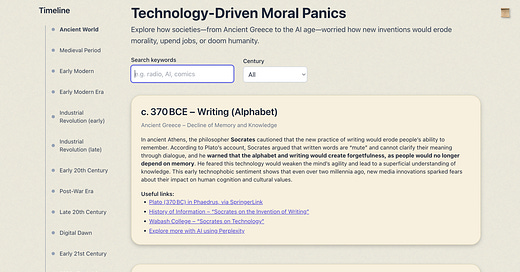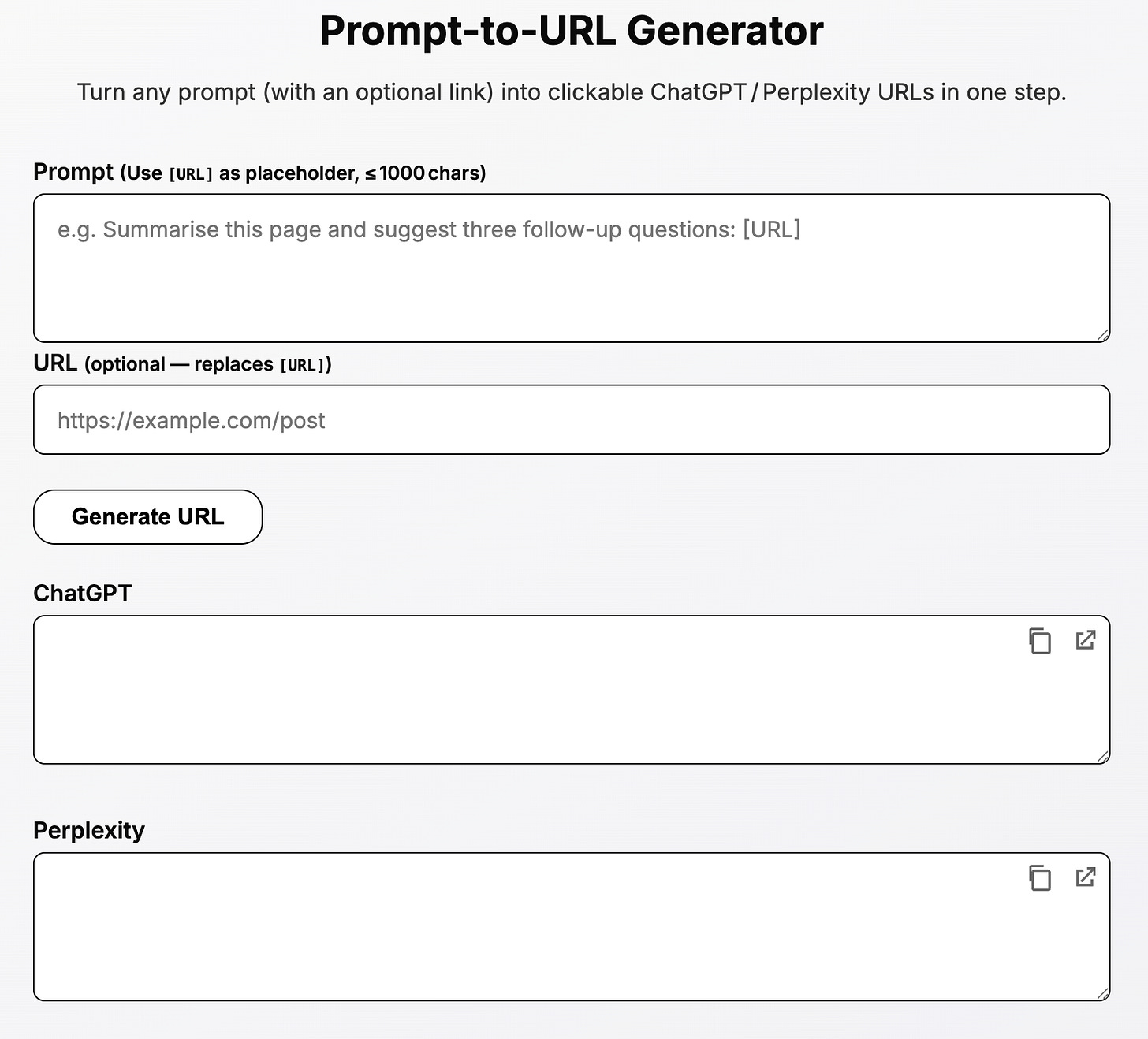Vibe coding moral panic
Not a panic about vibe coding, but an idle thought that led down a rabbit hole that turned into an online timeline on tech driven angst through the ages
This is more of a pre-vacation ramble than a full blown article. But I’m going with it anyway as I’m half way across the Atlantic and and heading toward three blissful unplugged weeks of vacation — and wanted to get something up before taking a short break from this Substack.
Plus, I’m having more fun than I suspect is proper “vibe coding” with ChatGPT!
Working in tech, society and the future, I’m no stranger to past examples of seemingly foolish moral angst and outrage over transformative emerging technologies. And yet I inevitably find that, when I need good examples to draw on, there’s a surprising dearth of simple websites that provide insights into tech-driven moral panic down the ages.1
And so in an idle moment over coffee I thought I’d “vibe code” one into existence.
This was only ever meant to be a 5 minute personal distraction. But as the vibe coded timeline grew, it sort of sucked me in.
For the uninitiated, "vibe coding” is new and trendy approach to coding2 where you tell an AI agent what you want to do in plain language, and the AI proceeds to spit out the relevant lines of code. It’s all about telling AI what you want — even if you’ve never coded in your life — and the AI translating this into something that’s executable.3
It’s a seductively dangerous slippery slope for people who don’t program for a living as, to be completely candid, the resulting code is about as reliable as the stuff amateurs like myself were churning out back in the 1980’s.
But therein also lies its charm for someone like me, as it gives me the chance to play with coding in a way that I haven’t been able to since those selfsame 80’s.
Back to my coffee-fueled idle moment though. Once again finding myself frustrated at the lack of an online timeline that did what I wanted, I asked ChatGPT to whistle up some code for a web page which displayed key moments in the history of technological moral panic on a simple interactive timeline — along with explanatory text that reflected my own work on tech and society.
24 hours later I realized that I probably shouldn’t have assumed this would be a 5 minute job!
The more I got into the coding and the content, the more useful I found the emerging website — to the extent that I thought it worth purchasing a relevant domain (techlashed.org — and yes, I was feeling a little tongue in cheek at the time) and unleashing it on the world:
Here I should confess that much of this wasn’t quite vibe coding — I had to do a lot of heavy lifting working with ChatGPT on functionality, design, and content.4 And yet, to someone as rusty as I am with HTML, Javascript and all the rest, 24 hours from idle thought to something that someone might find useful isn’t bad!
As ever with this type of project it seems, the website was 80% of the way there in the first hour. It was the details that took the time. And, as it turned out, much of this “detail” involved grappling with why I was creating the website in the first place, and what actually constitutes a moral techno-panic.
I spent a lot of time as a result going back and forth with ChatGPT on the list and the descriptions, constantly asking it to find cases that weren’t there, and to justify the ones that were.
The deeper I got, the more I had to grapple with what constituted a major technology-driven moral panic versus bulk standard fear-mongering or conspiracy theories. And I found myself constantly wrestling with what constituted a “technology” in this context.
As a result dungeons and dragons makes the list as a social technology, as does rock and roll — although these are most definitely borderline cases. But the moral panic brought along by miniskirts (I know!) in the 1960’s isn’t, neither are conspiracy theories around chemtrails or 5G.
And then there was the question of “why?”
It’s pretty usual to find articles on technological moral panics that focus on them as examples of humanity’s irrationality — and something to be mocked, or used to ridicule present-day panics. And yet this wasn’t the intent behind the timeline.
I’ve worked long enough at the intersection of technology, society and the future to know that these cases of tech-driven moral panic are rarely cut and dried. Rather, they reflect the deeply complex relationships we have with technology and the future; relationships that are intimately intertwined with human behaviors that are part of us all.
As a result, underneath the apparent irrationality and futility, they provide useful insights into the dynamics between tech and society that can be helpful in understanding and navigating the present — especially when seen from the perspective of how threats to what’s important to people can lead to responses that may seem irrational on the surface, but are usually more complicated underneath.
That said, the timeline is also a lot of fun to scroll through!
It’s also a timeline that includes a nod to another example of vibe coding that I’m particularly pleased with:
Along with each moral panic there are a handful of links to further resources. And the last one of these in each case is a link that takes you to a deeper exploration of the panic from the AI app Perplexity.
In each case that link was generated by another website that was a product of vibe coding: prompt2url.com.
This really was a simple case of me telling ChatGPT what I wanted, and a functional website being up and running within a few minutes.
It came from me needing a very simple way of encoding a prompt for an AI platform in a sharable web link.
There are only two AI platforms to my knowledge that allow this type of prompt encoding in an URL — ChatGPT and Perplexity — and prompt2url allows you to create a link for either.
This may no sound like a big deal, but the ability to create a sharable prompt link is a game changer when you realize what you can do with links like these.
Fo instance, want to know more about the Future of Being Human Substack? It’s now just a click away with Perplexity or ChatGPT, thanks to Prompt2URL 😀
And if you’re not convinced, give it a try for yourself!
Of corse, it could be argued that this, in itself, is a manifestation of an emerging technology which is poised to unleash a moral techno-panic.
We’ll see.
In the meantime, happy timeline and prompt2url-ing, and I’ll be back in a week or so with updates on, amongst other things, this year’s Top Ten Emerging Technologies from the World Economic Forum, which will be out later in June.
Until then.
Sadly I only discovered the Pessimist’s Archive after the timeline had been built!
It’s also rather controversial, as some worry that it leads to flaky and bug-ridden code if you don’t have the skills to spot what’s good practice and what’s not.
IBM has a useful summary of vibe coding here. It’s also worth checking out this MIT Technology Review article on its origins with AI expert Andrej Karpathy way back in February 2025 — yes, this is a new phenomenon, and it already feels old, such is the speed of AI!
My process was to start by asking ChatGPT (o3) to develop and refine a list of technology-driven moral panics, and to format this as a JSON file. The list — and the JSON categories for each record — took some time to iteratively refine. Next I asked ChatGPT to “create an interactive website using html/js/css that allows people to explore the timeline” — that’s the full extent of the initial vibe coding prompt! The first attempt was OK, but it then took many more iterations and multiple ChatGPT sessions to move from the initial website to something that had the timeline on the left, that was slick and responsive (the timeline moves to the top on a phone), that had an About card that integrated into the page, and that had a feel and look that I was happy with. And while most of this was developed with me showing ChatGPT screenshots and asking it to change aspects of the site (and debug when things didn’t work), there was also quite a bit of manual tweaking on my part.








Love the project - super fun read. Agree with some of these panics though, coffee is totally the origin of political dissent. 🤣
I haven’t tried vibe coding yet but I wanna!
Super cool. Shows what's possible with creative applications of AI - I think the coding piece is hugely overlooked with all the hand-wringing about the death of writing on Substack. Most coders aren't writing about writing - they're coding.